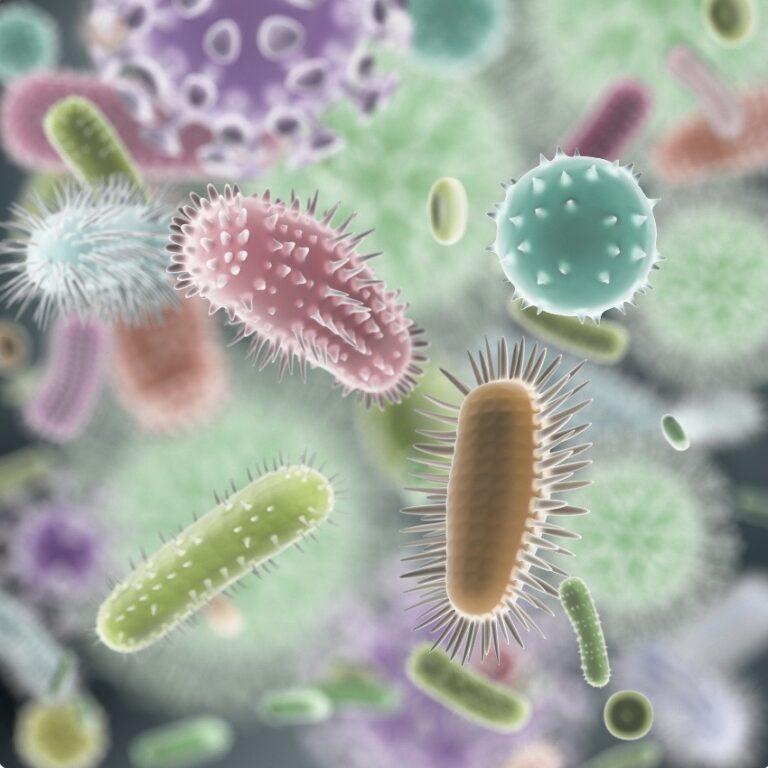There are many viruses in the world. It wasn’t until the invention of the electron microscope in the 1950s that viruses in patient samples could be detected, analysed and help the public health response to viral infections. But, what was the first virus ever discovered? In this blog post we will discuss the discovery of the 1st virus and some of its characteristics. Keep reading to learn more.
What is a virus?
Microbiology is the study of microorganisms like bacteria, viruses, fungi and algae. The study of viruses in particular, is known as virology and a person who studies viruses is called a virologist. A virus is a small infectious agent that can replicate only inside the living cells of other organisms. Viruses infect all types of life forms, from animals and plants to bacteria. Viruses are extremely diverse and come in many different shapes and sizes. Some viruses have a genome made of DNA, while others have a genome made of RNA. The genomes of viruses can range in size from a few genes to hundreds of genes.
Most viruses are regarded as pathogens, meaning that they cause disease. Some viral diseases, such as the flu or the common cold are mild, while others, such as AIDS or the Ebola virus, can be deadly. Viruses do not have their own genome or metabolic proteins, so they are unable to replicate on their own. Instead they rely on the genome and proteins of their host cells to produce new copies of themselves. For replication, viruses must first infect a host cell and hijack its machinery. Once inside the cell the virus begins to produce the proteins needed to build new viral particles. These new particles then assemble themselves and burst out of the host cell’s cell membrane, starting the cycle anew.
Although they are simple in structure, viruses are complex in terms of their biology. This complexity has made it difficult for scientists to develop vaccines for many viral diseases. However, recent advances in our understanding of virology may one day lead to more effective treatments for these diseases.
The first virus to infect a plant
Ivanovsky was a researcher in St. Petersburg, Russia, and in 1892 he was investigating a disease that was devastating tobacco crops in the Crimea. He observed that the plants were covered in a strange mosaic pattern, with discoloured patches of tissue. Ivanovsky initially suspected that bacteria caused the plant disease. He took sap from infected tobacco leaves and filtered it through a porcelain filter with small pores to block bacteria. Ivanovsky expected to see bacteria in the filtrate, but there were none. However, after conducting further experiments, he ruled out bacteria as the culprit. Instead he found that the Tobacco Mosaic virus was responsible for the plant disease.
This was the first time that a virus had been discovered. Ivanovsky’s discovery was groundbreaking; it was the first time a virus had been isolated and identified. Ivanovsky’s work laid the foundation for future research on viruses and their role in causing disease. His finding also helped to pave the way for future discoveries in the field of virology.
The first virus human virus
The yellow fever virus is a mosquito-borne virus that was first discovered in 1901. The virus is responsible for causing a severe and often fatal disease called yellow fever. It is spread by the Aedes aegypti mosquitoes which also spread other serious viruses such as Dengue and Zika. It can be difficult to diagnose because of its similarities to other diseases such as malaria and other hemorrhagic fevers. Yellow fever virus is classed as a vector-borne disease. Vectors are insects, ticks or mites which can transmit diseases to their host i.e. Aedes aegypti mosquitoes carry the pathogen to their human host.
The first recorded outbreak of yellow fever occurred in Africa in the early 1800s, and the disease quickly spread to other parts of the world, including the Americas. In response to the outbreak, a team of researchers led by Dr Walter Reed travelled to Africa to study the disease. Reed and his team discovered that the yellow fever virus was transmitted by mosquitoes. They developed a vaccine that could protect people from the disease. The yellow fever vaccine was later used to control outbreaks in the Americas, where it remains an important tool for preventing the spread of the disease today.
How does your body respond to viral infection?
The immune system of an infected person begins to produce antibodies in response to a virus. Antibodies are proteins that recognise and bind to foreign invaders, such as viruses. This binding helps to neutralise the virus and prevent it from infecting cells.
The immune system also produces specialised cells, known as memory cells. Memory cells remain in the body after an infection has cleared and help to protect against future infections with the same virus. When a person is vaccinated their body is exposed to a weakened form of the virus. This exposure stimulates the immune system to produce antibodies and memory cells. As a result the person is immune to future infection from the virus.
In some cases the immune response can clear the virus from the body entirely. However, in other cases the virus can replicate and cause infectious diseases. The body’s response to viral infection depends on several factors, including the individual’s immune system strength, health conditions and the specific type of virus. In general however, the immune system is typically able to mount an effective response against most viral infections.
Unlike bacterial infections, viral diseases don’t respond to antibiotics. People will need either a vaccination to prevent infection or antiviral drugs to treat any symptoms. Sometimes the only option is symptom relief.
Other virus discoveries
- In 1965 the Hepatitis B virus was discovered by Dr Baruch Blumberg who won the Nobel Prize for its discovery
- In 1908 in Vienna, polio was discovered to be a virus by Karl Landsteninrt and Erwin Popper
- The Herpes virus was not found to be a virus until the 1940s
- The Marburg virus belongs to the same family of viruses that causes the Ebola virus disease. It was first identified in 1967 after two large outbreaks in Marburg and Frankfurt, in Germany, and Belgrade, in Serbia. These first reported cases were seen in laboratory workers carrying out studies with African green monkey tissue samples from Uganda. In total thirty-one people fell sick and seven deaths were reported. The World Health Organization (WHO) recently confirmed that two cases of the Marburg virus have been detected in the Ashanti Region of Southern Ghana West Africa on July 7th 2022
- In 1983 HIV was discovered, the virus that can lead to AIDS (acquired immunodeficiency syndrome), sometimes described as one of the deadliest diseases in the world today
- SARS-CoV (Severe Acute respiratory syndrome coronavirus) is a strand of coronavirus that attacks the epithelial cells of the lungs. First identified in 2003 in China. A new strain of SARS-CoV, SARS-CoV-2 is what caused the new coronavirus pandemic that began in 2019. This new virus spread incredibly quickly from person to person
Viruses have been around for millions of years and are some of the oldest and most primitive life forms on Earth. The first viruses to be discovered were small, simple and barely alive. Today’s viruses are much more complex and can cause serious illness or death. If you think you may have contracted a virus it is important to speak to your healthcare professional for medical advice. Early diagnosis and treatment are essential for the best possible outcome.
Sources
Medical Disclaimer
NowPatient has taken all reasonable steps to ensure that all material is factually accurate, complete, and current. However, the knowledge and experience of a qualified healthcare professional should always be sought after instead of using the information on this page. Before taking any drug, you should always speak to your doctor or another qualified healthcare provider.
The information provided here about medications is subject to change and is not meant to include all uses, precautions, warnings, directions, drug interactions, allergic reactions, or negative effects. The absence of warnings or other information for a particular medication does not imply that the medication or medication combination is appropriate for all patients or for all possible purposes.






